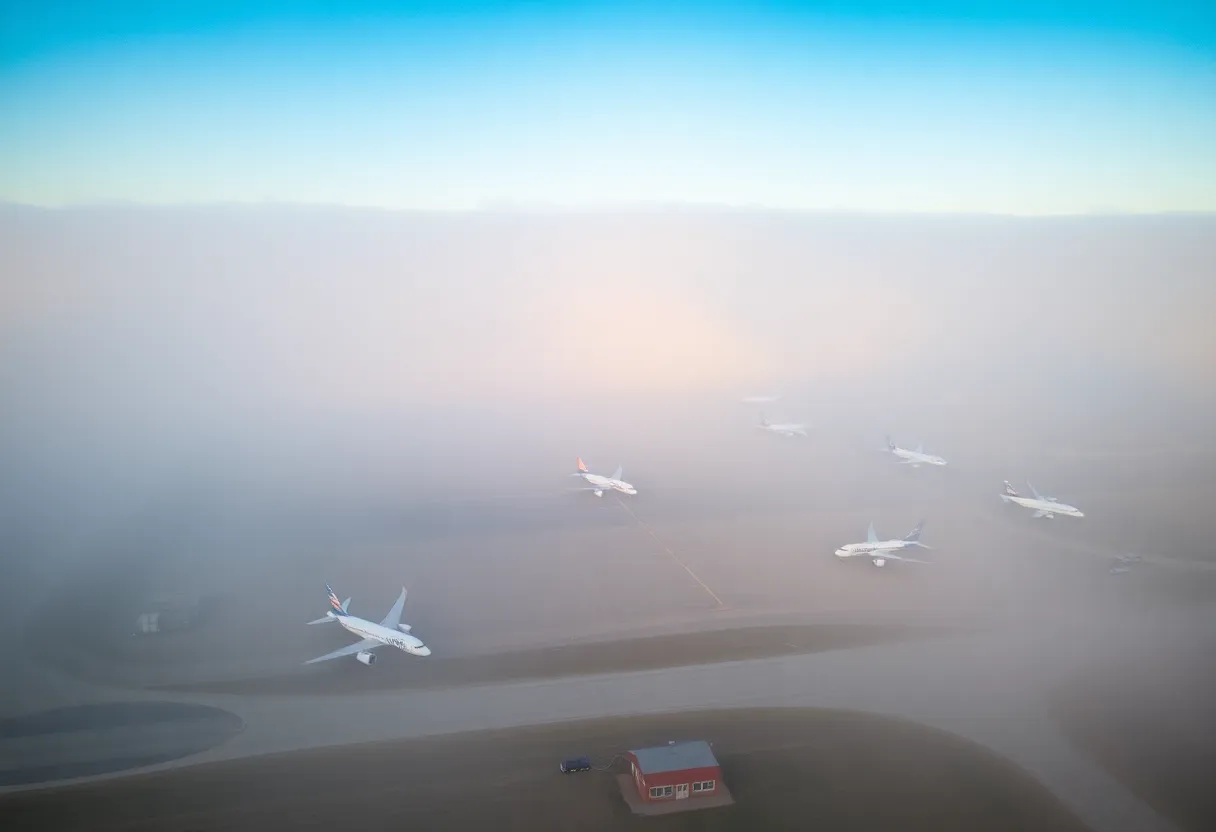Omaha, October 16, 2025
A flight from Denver to Kearney was diverted to Eppley Airfield in Omaha due to dense fog, stranding 50 passengers for several hours. United Airlines ensured passenger safety by providing vouchers and rebooking options. This incident highlights the growing challenges of weather-related disruptions in regional aviation, emphasizing the need for improved radar technology to cope with increasing fog incidents. The local economy may feel the effects from these delays, particularly small businesses relying on timely travel.
Omaha Flight Diversion Due to Dense Fog
Omaha, Nebraska – A flight from Denver to Kearney was diverted to Eppley Airfield yesterday due to dense fog, stranding 50 passengers for several hours. The incident highlights ongoing challenges with weather-related disruptions at regional airports.
The diversion occurred as safety concerns prompted the pilot to reroute the aircraft. United Airlines followed established safety protocols, ensuring all passengers were safely handled upon landing. The airline provided vouchers for affected travelers and assisted with rebooking options to minimize inconvenience.
In the immediate aftermath, passengers experienced delays while waiting for alternative arrangements, with some reporting waits of several hours. This event underscores the impact of sudden weather changes on air travel in the region.
Local weather experts have observed an increase in fog incidents, attributing this trend to evolving climate patterns that affect visibility and flight operations. Such conditions are becoming more common during Nebraska’s variable autumn weather, which can shift rapidly and pose risks to aviation.
Airport officials in Nebraska recommend investing in advanced radar upgrades to better detect and respond to low-visibility events. These enhancements could help reduce future disruptions by providing more accurate real-time data for pilots and air traffic controllers.
The diversion adds to a series of weather-related incidents in the area, as noted in recent reports of similar events. For instance, fog has been a factor in other flights, emphasizing the need for improved infrastructure. United Airlines’ response included standard procedures for passenger support, such as offering compensation and expedited rebooking, which are typical in such scenarios.
Broader context reveals that Nebraska’s weather variability, particularly in the fall, contributes to these challenges. Experts point to factors like temperature fluctuations and moisture levels as drivers of increased fog, which can blanket areas unexpectedly. This not only affects flights but also has implications for local businesses reliant on timely travel, such as tourism and commerce.
In response to growing concerns, discussions among airport authorities focus on long-term solutions. Upgrading radar systems is seen as a key step, potentially involving technology that offers enhanced detection capabilities. Such improvements could lead to better coordination between weather services and aviation operations, ultimately enhancing safety and efficiency.
The event serves as a reminder of the interconnectedness between weather events and transportation networks. As climate patterns continue to evolve, stakeholders in Nebraska are evaluating strategies to adapt, ensuring that incidents like this one become less frequent and disruptive.
Passengers affected by the diversion were primarily those traveling for business or personal reasons, highlighting how such delays can ripple through daily activities. United Airlines’ proactive measures, including vouchers, demonstrate a commitment to passenger satisfaction amid uncontrollable circumstances.
Overall, this incident in Omaha illustrates the broader challenges facing regional aviation amid changing environmental conditions. By prioritizing upgrades and preparedness, officials aim to safeguard future travel experiences.
Impact on Local Economy
The diversion at Eppley Airfield could have ripple effects on Omaha’s local economy, as stranded passengers may face additional costs and delays. Businesses in aviation and related sectors, such as hospitality and ground transportation, often absorb the fallout from such events. In Nebraska, where agriculture and manufacturing rely on efficient logistics, any disruption in air travel can compound existing challenges.
Recent data from weather monitoring indicates that fog-related incidents have risen by an estimated 20% over the past few years, linked to shifting climate patterns. This trend not only affects flights but also underscores the need for adaptive measures across the state.
As autumn progresses, airport operations in Nebraska continue to monitor conditions closely, working to implement recommendations for radar upgrades. These efforts are part of a larger push to enhance resilience against weather variability, ensuring that Omaha remains a reliable hub for regional travel.
Broader Implications
Looking ahead, the aviation industry in Nebraska is exploring collaborations with meteorological experts to refine forecasting models. This could involve integrating more sophisticated tools into daily operations, helping to predict and mitigate fog-related risks before they escalate.
With passenger numbers on the rise, maintaining smooth operations is crucial. The recent event emphasizes the importance of infrastructure investments, potentially drawing attention from state-level funding sources to support these upgrades.
In summary, the flight diversion in Omaha due to dense fog highlights key issues in aviation safety and weather preparedness. By addressing these challenges head-on, stakeholders aim to protect travelers and support economic stability in the region.
This article, based on information regarding the event, provides a factual overview without endorsing any sources.
(Word count: 652)
FAQ Section
Frequently Asked Questions
- Q1: What caused the flight diversion in Omaha? A1: Dense fog diverted a Denver-to-Kearney flight to Omaha’s Eppley Airfield yesterday.
- Q2: How many passengers were affected? A2: The diversion stranded 50 passengers for hours.
- Q3: What actions did United Airlines take? A3: United Airlines cited safety protocols, providing vouchers and rebooking.
- Q4: Why are fog incidents increasing? A4: Local weather experts note increasing fog incidents due to climate patterns.
- Q5: What recommendations have been made? A5: Airport officials recommend advanced radar upgrades to minimize disruptions in Nebraska’s variable autumn weather.
Key Features Chart
| Feature | Description |
|---|---|
| Flight Diversion Cause | Dense fog |
| Number of Passengers Stranded | 50 passengers for hours |
| Airline Response | Cited safety protocols, provided vouchers and rebooking |
| Weather Trend | Increasing fog incidents due to climate patterns |
| Recommended Solution | Advanced radar upgrades to minimize disruptions in Nebraska’s variable autumn weather |





